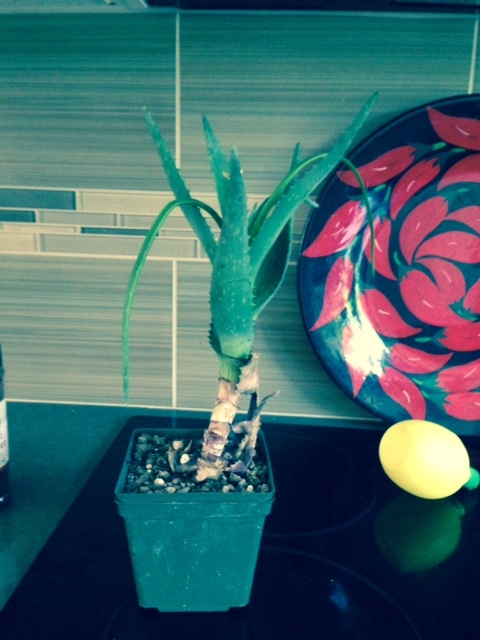Advice for the Home Gardener From the Contra Costa Master Gardeners' Help Desk
Client's Questions & Concerns:
Client called in and also sent email with picture asking whether her aloe needed repotting. Plant appeared to be in original 4" pot. She also wanted to know why the plant was drooping.
Response from the CCMG Help Desk
You want to choose a pot that is wider and deeper than the current plant, with space for the plant to grow. The new pot can be plastic or clay/ceramic. Given the top-heavy nature of an aloe you may want to use a clay or ceramic pot. Any pot you select should have one or more drainage holes in the bottom. You can use commercial cactus mix as your planting medium.
Before planting, lightly cover the drainage holes with a piece of clay or a screen. Note: Do not place pebbles or multiple layers of clay pieces in the bottom of the pot "to improve drainage". Recent research has shown that the pebbles do not improve drainage; they just limit the space for the roots.
To repot, remove the plant from the current pot, clearing away the old soil from the roots. I noticed that you have a "pup" in the corner of the current pot. You will want to cut the pup from the main plant. You can plant it separately if you want. Place the plant(s) in the new pots with the cactus mix. The main plant can be planted with the lowest leaves at the soil level, i.e., with the bare stem buried. Allow the plant(s) to rest out of direct sunlight without water for the first week or two after repotting. This allows time for roots that may have been damaged in the transplanting process to heal.
There are several environmental factors that could be causing the drooping problem. One is water. Aloes should be watered approximately once a week through the growing season (spring to fall). Aloes need less water during the winter, but you do need to make sure that it gets enough water to avoid shriveling. You especially want to make sure that the plant does not fully dry out once you start watering it this winter after the transplant waiting period is over. However, you should let it dry out the top 1-2" between waterings (you can stick your finger and/or popsicle stick to check, etc.).
A second factor is fertilization. The plant looks like it had some sudden new growth. Like many houseplants, aloes do well with regularly applied diluted fertilizer during the growing season, with no fertilizer during the dormant (winter) season.
A third factor is light. Your plant may need additional light. A west or south facing window is best. Care must be used when introducing additional light or moving the plant to a brighter location. The plant should be introduced to the additional light gradually to avoid scorching.
For more information on repotting and growing succulents and cactus see: http://www.csssj.org/welcome_visitors/basic_culture.html.
For specific information on aloes, see: http://homeguides.sfgate.com/plant-aloe-vera-container-80791.html and
for indoor succulents http://homeguides.sfgate.com/indoor-potted-succulents-dying-80564.html.
And for a view of Aloes and other succulents in a garden setting (with some in pots as well in the nursery), you should visit The Ruth Bancroft Garden in Walnut Creek. This is a world-class garden utiliizing succulents and other water-aving plants in settings that can be inspiration for your home and garden.
Good luck with your aloe.
Please let us know if you have further questions.
Contra Costa Master Gardeners Help Desk
Note: The Contra Costa Master Gardener Help Desk is available year-round to answer your gardening questions. Except for a few holidays, we're open every week, Monday through Thursday for walk-ins from 9:00 am to Noon at 75 Santa Barbara Road, 2d Floor, Pleasant Hill, CA 94523. We can also be reached via telephone: (925) 646-6586, email: ccmg@ucanr.edu, or on the web at http://ccmg.ucanr.edu/Ask_Us/